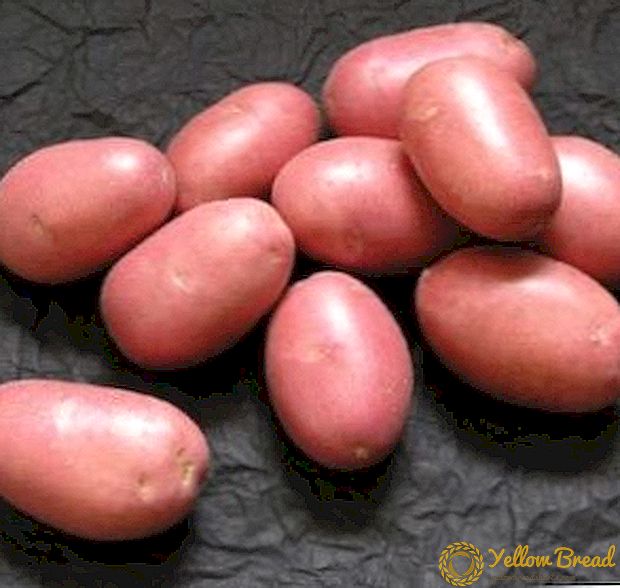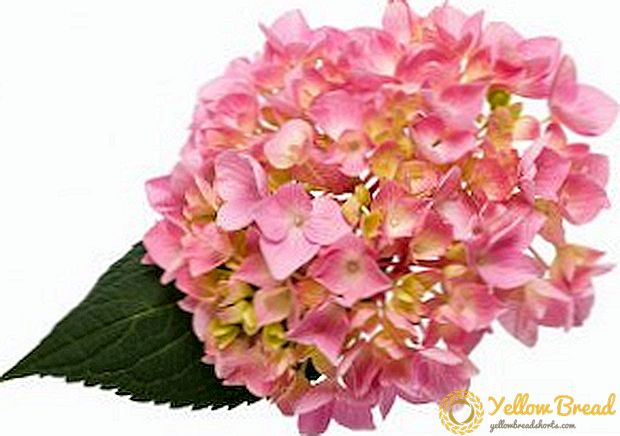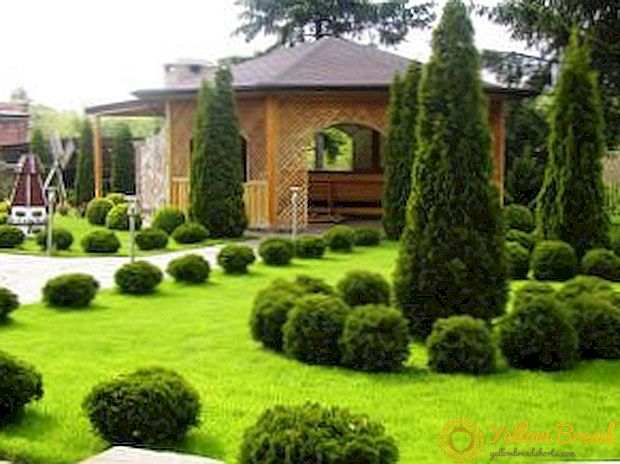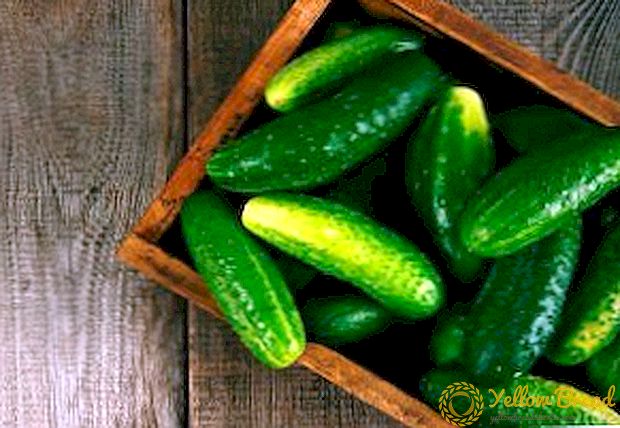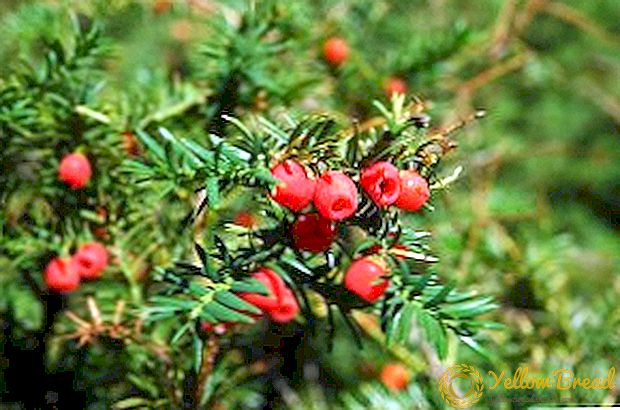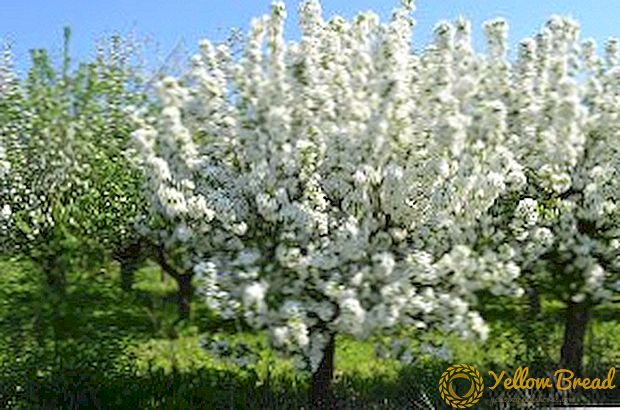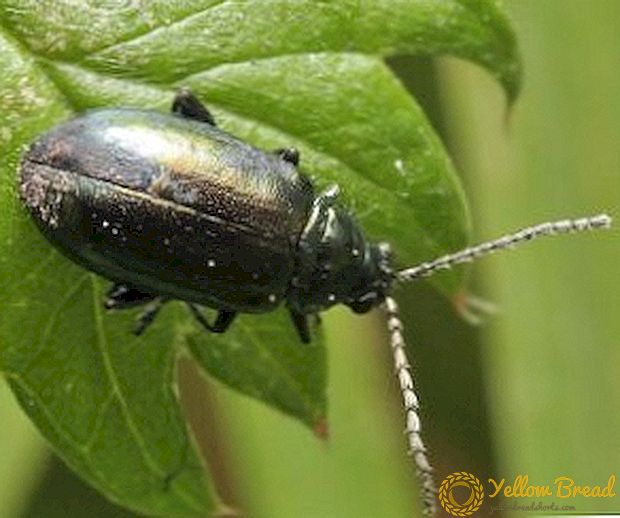 One of the most dangerous pests of radish called cruciferous flea. They live everywhere, so every gardener can meet them.
One of the most dangerous pests of radish called cruciferous flea. They live everywhere, so every gardener can meet them.
Let's see what these pests can do with radish and what are the ways to combat them.
- Pest description
- Possible consequences
- Signs of cruciferous flea on radish
- Methods of struggle
- Folk remedies
- Chemicals
- Pest prevention
Pest description
Cruciferous flea has a very small size - no more than 3 mm. Often, gardeners do not pay attention to them, because the bugs are so small that they merge with the ground. The black color helps them to remain invisible, but some types of flea have yellow stripes on their backs.  Bugs wake up after winter as soon as the earth thaws. Adults in the spring eat mostly weeds (wild radish, field yarut, rape and others), and then black fleas switch to radish and other cruciferous plants.
Bugs wake up after winter as soon as the earth thaws. Adults in the spring eat mostly weeds (wild radish, field yarut, rape and others), and then black fleas switch to radish and other cruciferous plants.
Possible consequences
For radishes, fleas are very dangerous - they eat away thin and delicate leaves to holes, after which they dry out. A large number of flea beetles can destroy the entire radish in the garden in 2-3 days: adult bugs will eat leaves and eat the skin on the stalks, while the larvae will destroy the roots of the plant.  It is necessary to fight the cruciferous flea on the radish immediately after you notice it, and even better to carry out prevention during planting.
It is necessary to fight the cruciferous flea on the radish immediately after you notice it, and even better to carry out prevention during planting.
Signs of cruciferous flea on radish
The main signs of infection of the radish by the cruciferous flea are:
- the presence on the plant of small bugs that jump in all directions, if you disturb the leaf;
- leaves of the plant are thin and skeletal;
- the presence of holes in the leaves;
- leaf mining (leafs are gnawed inside the leaves).

Methods of struggle
With these insects are struggling with both chemical and folk remedies. If the owner of the site is rarely in the country, then it will be more convenient for him to use chemical means to combat fleas.
But gardeners who are constantly on the site, can defeat the bugs and folk remedies.
Folk remedies
To get rid of fleas on a radish, you can use such a tool as ordinary vinegar. In a bucket of water you need to dilute the bottle of vinegar and process the affected culture in dry weather. Good help in the fight against pest tincture of 500 g of the roots and leaves of dandelion and a bucket of water.
 A large amount (2-4 kg) of fresh or dried tomato or potato tops must be soaked for four hours in 10 liters of water, then boiled, cooled and filtered.Then dilute the broth with water 1: 1.
A large amount (2-4 kg) of fresh or dried tomato or potato tops must be soaked for four hours in 10 liters of water, then boiled, cooled and filtered.Then dilute the broth with water 1: 1.If there is an extra ready decoction, you can not pour it out, but keep it until the next season, having tightly closed the lid.
It is well helped by powdering the soil on which radishes grow, with wood ash, naphthalene or tobacco dust. This powder will be a good protection against flea and a useful fertilizer at the same time. The procedure will be effective if it is done every 4-5 days at least three times.
Flap on the radish can be overcome with several other folk remedies. The tops of the plants can be sprinkled in the early morning on the dropped out dew with black ground pepper or slaked lime. Experienced gardeners come up with various insect traps.  Often there are special sheds over the beds, the underside of which are smeared with something sticky (tar, grease, tar). A few days later, the flea will stick to the trap and it will need to be changed to a new one.
Often there are special sheds over the beds, the underside of which are smeared with something sticky (tar, grease, tar). A few days later, the flea will stick to the trap and it will need to be changed to a new one.
Chemicals
Before splashing radish with insecticide from flea, you should try to fight it with natural means. If they did not help, you can proceed to the use of special drugs. 
The most effective insect control chemicals are:
- Actellic;
- "Decis";
- "Intavir";
- Aktara;
- Bankol;
- "Karate";
- "Sherpa";
- Tabazol;
- Kaiser;
- Zolon.
 Before treating all shoots, it is necessary to check the drug on a single plant. Then you need to watch the processed radish day and, if its condition has not worsened, you can continue to process the culture. Sprayed with chemicals usually in the evening, when the sun had already gone down.
Before treating all shoots, it is necessary to check the drug on a single plant. Then you need to watch the processed radish day and, if its condition has not worsened, you can continue to process the culture. Sprayed with chemicals usually in the evening, when the sun had already gone down.It is important to remember to observe all safety rules during the treatment of plants with chemicals, in order not to accidentally poison yourself and not to receive chemical burns. It is possible to collect and eat radishes, which have been processed, only after a month from the day of spraying. 
Pest prevention
The appearance of cruciferous flea on a radish is easier to prevent than to try to fight it with all your might.Cruciferous flea are afraid of a wide variety of smells. For the prevention of the appearance of an insect, radishes should be surrounded by such plants:
- tansy;
- coriander;
- caraway;
- celandine;
- nasturtium;
- dill;
- tomato;
- potatoes;
- garlic.
 It is important to feed the radish, regularly water and loosen the land in which it grows.So its development will go much faster, the leaves will become more rough, and the flea will not have time to cause radish significant harm.
It is important to feed the radish, regularly water and loosen the land in which it grows.So its development will go much faster, the leaves will become more rough, and the flea will not have time to cause radish significant harm.You can try to cover radishes with spanbond or lutrasil, which easily let air, light and water through, and also protect the young plant from insect attacks.
Cruciferous flea - a very dangerous insect for young radish. But by learning to prevent their occurrence and fight them, you can avoid the death of the plant.

